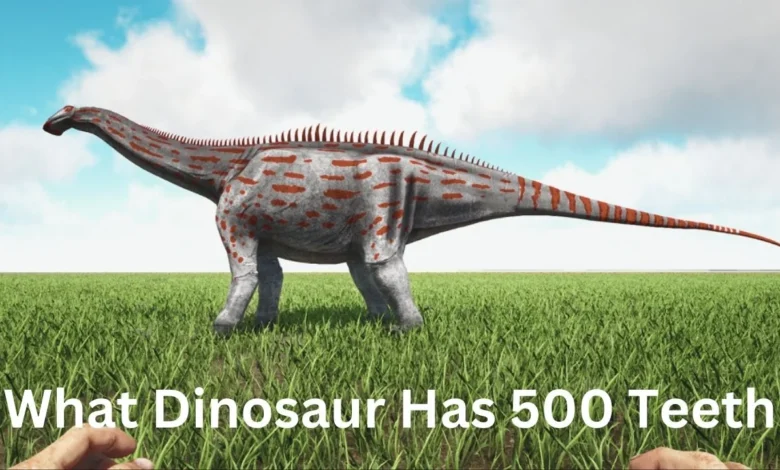What Dinosaur Has 500 Teeth?

When people ask, “what dinosaur has 500 teeth?” they are referring to a unique prehistoric creature called Nigersaurus. This fascinating dinosaur was first discovered in the Republic of Niger in Africa. Nigersaurus is known for its unusual number of teeth, a staggering 500, which helped it feed in a special way. This article will explore everything about Nigersaurus, its lifestyle, its habitat, and, most importantly, why it had so many teeth.
What Was Nigersaurus?
Nigersaurus was a sauropod dinosaur, meaning it belonged to the group of long-necked dinosaurs that include famous species like Brachiosaurus and Apatosaurus. Nigersaurus lived about 115 to 105 million years ago during the middle Cretaceous period. Despite its large number of teeth, Nigersaurus was not a predator. Instead, it was a herbivore, meaning it ate plants.
With a length of around 30 feet and a relatively lightweight frame for a sauropod, Nigersaurus roamed the plains of what is now the Sahara Desert. Its unusual skull and teeth structure set it apart from other dinosaurs, which is why the question “what dinosaur has 500 teeth?” is so interesting to many people.
How Did Nigersaurus Use Its 500 Teeth?
The most curious thing about Nigersaurus is how it used its 500 teeth. Nigersaurus was a specialized plant-eater, and its teeth were designed to help it graze low-lying plants and vegetation. Unlike other dinosaurs that might have grabbed leaves from tall trees, Nigersaurus had a wide, flat mouth that worked like a vacuum cleaner for scooping up plants from the ground.
Each tooth was small and replaced frequently, with new teeth growing in as old ones wore out. This allowed Nigersaurus to constantly have fresh teeth ready for chewing its food. The answer to “what dinosaur has 500 teeth” becomes clear when you understand that Nigersaurus needed many teeth for its constant feeding on tough, fibrous plants.
What Dinosaur Has 500 Teeth: Where Was Nigersaurus Discovered?
Nigersaurus was discovered in the late 20th century in the Sahara Desert, specifically in the Republic of Niger. The first fossils were found by French paleontologist Philippe Taquet in the 1970s, but it wasn’t until later that a more complete skeleton was recovered. A team led by American paleontologist Paul Sereno helped bring attention to Nigersaurus in the early 2000s.
The discovery of Nigersaurus fossils gave scientists a clear view of what this strange dinosaur looked like, including its 500 teeth. Its discovery helped answer many questions about dinosaurs that lived in the African continent during the Cretaceous period.
What Was Nigersaurus’ Habitat Like?
Nigersaurus lived in what is now the Sahara Desert, but during its time, the area was much different. Instead of dry sand dunes, Nigersaurus roamed lush floodplains filled with rivers and vegetation. The climate was warm and wet, making it a perfect environment for herbivores like Nigersaurus to thrive.
These plains were filled with low-lying ferns, cycads, and other soft plants that Nigersaurus could easily graze with its wide, tooth-filled mouth. The 500 teeth helped the dinosaur chew through these plants quickly. Other dinosaurs, including large carnivores, also lived in the region, creating a dynamic ecosystem.
What Made Nigersaurus Different from Other Dinosaurs?
One of the most remarkable things about Nigersaurus is its skull. Unlike many other sauropods, Nigersaurus had a very lightweight and fragile skull, which made it seem unusual for such a large creature. The teeth of Nigersaurus were tightly packed in rows, creating a kind of “tooth battery” that allowed it to feed efficiently.
The shape of its skull was also different. Its jaw extended wider than its skull, giving it a broad, square-shaped mouth that was ideal for grazing. When people ask, “what dinosaur has 500 teeth,” they are often surprised to learn that this strange mouth and dental structure made Nigersaurus stand out from other herbivores.
How Did Nigersaurus Eat?
Nigersaurus was a low-browser, meaning it fed on plants close to the ground. The 500 teeth in its mouth allowed it to mow down plants like a lawnmower. Its wide mouth and closely packed teeth made it perfect for grazing on soft vegetation. Nigersaurus didn’t need to pull leaves from trees; instead, it fed on ferns, horsetails, and other low-growing plants.
Scientists believe that Nigersaurus kept its head close to the ground while it walked, using its broad mouth to scoop up large amounts of food. Its teeth, which were always being replaced, helped it chew through tough plants without wearing out its teeth.
Why Did Nigersaurus Have So Many Teeth?
The main reason Nigersaurus had 500 teeth was to help it eat as efficiently as possible. As a herbivore, Nigersaurus needed to chew through large amounts of plant material every day. Having so many teeth allowed it to continue feeding even as its teeth wore down.
Its teeth were arranged in rows and replaced constantly, making sure that it always had sharp teeth ready for use. This unique adaptation allowed Nigersaurus to thrive in its environment, even though its diet consisted mostly of tough, fibrous plants.
What Are the Pros and Cons of Nigersaurus’ Teeth?
Understanding the benefits and limitations of Nigersaurus’ 500 teeth provides insight into how it survived in its environment. Here’s a breakdown of the pros and cons of its teeth:
| Pros | Cons |
|---|---|
| Efficient feeding on large quantities of low-lying plants. | Teeth wore out quickly due to constant use. |
| Ability to constantly replace worn-out teeth. | Limited to feeding on soft plants and low vegetation. |
| Wide mouth allowed for more effective grazing. | Fragile skull made it vulnerable to predators. |
| Specialized teeth for a unique diet. | Dependent on lush environments for survival. |
What Did Nigersaurus Look Like?
Nigersaurus was a relatively small sauropod compared to giants like Brachiosaurus. It measured about 30 feet in length and had a small, lightweight frame. Its most noticeable feature was its wide mouth and tooth battery, which housed 500 teeth.
It had a long neck, typical of sauropods, but its neck was shorter than other long-necked dinosaurs. Its body was balanced by a long tail, and it walked on four sturdy legs. Despite its unusual skull, Nigersaurus still had many features in common with other sauropods, such as its general body shape and long neck.
What Other Dinosaurs Lived During Nigersaurus’ Time?
Nigersaurus lived during the mid-Cretaceous period, a time when many other dinosaurs roamed the Earth. In the same region where Nigersaurus was found, large carnivores like Spinosaurus and Carcharodontosaurus also lived. These predators likely posed a threat to Nigersaurus, although its large size may have offered some protection.
In addition to these large carnivores, other herbivorous dinosaurs, such as Ouranosaurus, shared the same environment. These dinosaurs likely competed for similar food sources, although their different feeding styles allowed them to coexist.
Conclusion: What Dinosaur Has 500 Teeth
So, what dinosaur has 500 teeth? The answer is the fascinating Nigersaurus. This unique dinosaur had a specialized feeding mechanism that allowed it to thrive in its environment. With its 500 teeth, Nigersaurus was able to graze on low-lying plants and constantly replace worn-out teeth to maintain its diet. Living in the lush floodplains of what is now the Sahara Desert, Nigersaurus was a remarkable example of how dinosaurs adapted to their surroundings.
Understanding the 500 teeth of Nigersaurus helps us appreciate the diversity of life that existed during the age of dinosaurs. From its wide mouth to its ability to replace teeth, Nigersaurus stands out as one of the most interesting herbivores to have ever lived.




